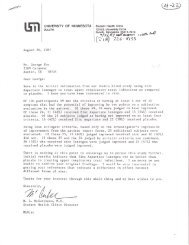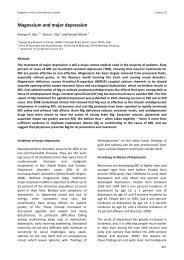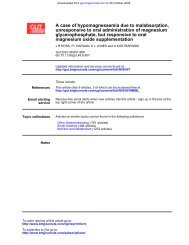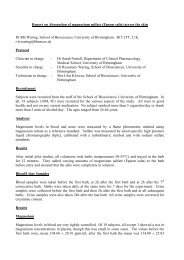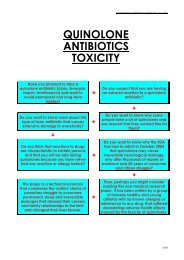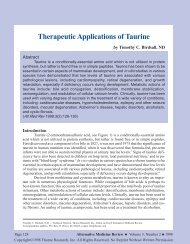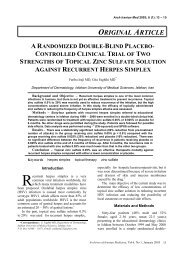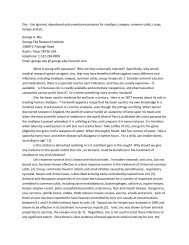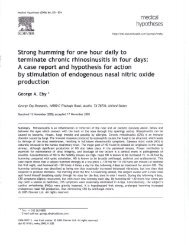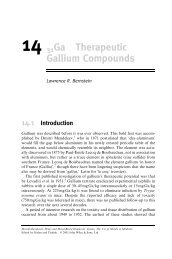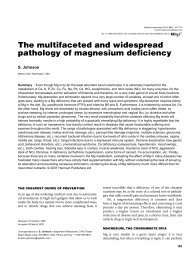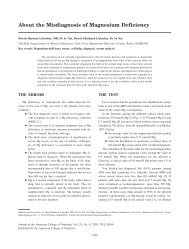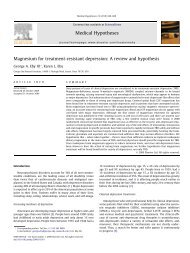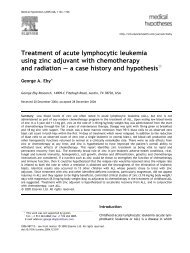10th International Magnesium Symposium Schedule of Events
10th International Magnesium Symposium Schedule of Events
10th International Magnesium Symposium Schedule of Events
Create successful ePaper yourself
Turn your PDF publications into a flip-book with our unique Google optimized e-Paper software.
21<br />
The CorA-Mrs2 superfamily <strong>of</strong> Mg2+ transport proteins in bacteria and<br />
mitochondria<br />
Elisabeth Froschauer 1 , Martin Kolisek 1 , Martin Piskacek 1 , Gabor Zsurka 1 , Julian<br />
Weghuber 1 , Monika Schweigel 2 , Rudolf J. Schweyen 1 . 1 Max Perutz Laboratories,<br />
Department <strong>of</strong> Microbiology and Genetics / University <strong>of</strong> Vienna, Campus Vienna<br />
Biocenter Dr. Bohrgasse 9, A-1030 Vienna, Austria; 2 Free University Berlin,<br />
Institute <strong>of</strong> Veterinary-Physiology, Oertzenweg 19b, D-14163 Berlin, Germany.<br />
rudolf.schweyen@univie.ac.at<br />
The CorA proteins <strong>of</strong> bacteria and the Mrs2 proteins <strong>of</strong> mitochondria are<br />
characterized by the presence <strong>of</strong> two adjacent transmembrane domains. The only<br />
sequence conserved among them (Y/F-G-M-N) is a short motif at the end <strong>of</strong> one <strong>of</strong><br />
these domains. Functional homology <strong>of</strong> these proteins is evident from the fact that<br />
mitochondrial defects <strong>of</strong> Mrs2p lacking yeast cells (mrs2D mutants) are cured by the<br />
expression <strong>of</strong> either the bacterial CorA protein or the human Mrs2 protein. Growth <strong>of</strong><br />
CorA mutant bacterial cells are Mg2+ -dependent, mrs2D yeast cells show<br />
unconditional mitochondrial defects, but stay viable, while human mrs2D cells are<br />
unviable.<br />
Similarity between CorA and Mrs2 proteins further extends to the Mg2+ fluxes across<br />
membranes. By use <strong>of</strong> the fluorescent, Mg2+ -sensitive dye mag-fura 2 we have<br />
recently determined Mg2+ fluxes across bacterial plasma membranes as well as<br />
across yeast and human mitochondrial membranes. The CorA and Mrs2 proteins<br />
mediate rapid, high- capacity influx into bacterial cells and into isolated mitochondria,<br />
respectively. Addition <strong>of</strong> 10 mM Mg2+ to isolated mitochondria can result in an<br />
increase <strong>of</strong> intramitochondrial free Mg2+ by as much as 50% per second, with a<br />
pronounced saturation at about 5 mM in yeast mitochondria. The driving force for<br />
Mg2+ influx by both, CorA and Mrs2 proteins is the high (inside negative) membrane<br />
potential <strong>of</strong> mitochondria and bacteria. Mg2+ influx studies suggest the presence <strong>of</strong><br />
Mg2+ channels in the bacterial and mitochondrial membranes. This notion is<br />
supported by cross-linking studies in yeast and human mitochondrial membranes,<br />
revealing the presence <strong>of</strong> homo-oligomeric Mrs2 protein complexes.



